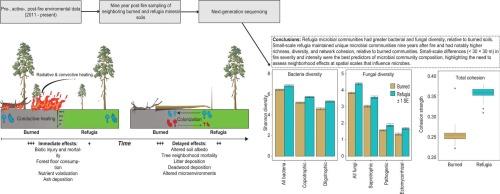小规模的火灾避难所增加了土壤细菌和真菌的丰富度,并增加了火灾后9年的群落凝聚力
IF 8
1区 环境科学与生态学
Q1 ENVIRONMENTAL SCIENCES
引用次数: 0
摘要
野火行为的小规模变化可能导致地下细菌和真菌群落的巨大差异,从而影响地下微生物的多样性、群落组合和功能。在这里,我们将混合针叶林的火灾前、火灾中和火灾后的测量相结合,以确定野火行为、未燃烧的庇护所和地上森林结构如何与野火发生9年后的地下细菌和真菌群落相关联。我们使用小(0.9-172.6 m2)避难所的精细比例尺制图来采样与土壤相关的烧毁和避难所微生物群落。土壤中细菌(+ 19%)和真菌(+ 31%)的丰富度均高于燃烧土壤。与烧毁土壤相比,避难群落腐坏性真菌比例更高,致病性真菌比例更低。在不同的烧毁区和避难所,其组成不同,且与小规模火灾行为、地上活树基底面积和树木死亡率密切相关。相对于烧焦的土壤,难民社区有更多的联系网络和更少的促进性相互作用,这既支持了应力梯度假设,也支持了难民社区可能对未来干扰有更大抵抗力的结论。野火行为和影响的小规模差异可能对地下微生物产生长期影响,这突出了在空间尺度上评估影响微生物的邻里效应的必要性。本文章由计算机程序翻译,如有差异,请以英文原文为准。

Small-scale fire refugia increase soil bacterial and fungal richness and increase community cohesion nine years after fire
Small-scale variation in wildfire behavior may cause large differences in belowground bacterial and fungal communities with consequences for belowground microbial diversity, community assembly, and function. Here we combine pre-fire, active-fire, and post-wildfire measurements in a mixed-conifer forest to identify how fine-scale wildfire behavior, unburned refugia, and aboveground forest structure are associated with belowground bacterial and fungal communities nine years after wildfire. We used fine-scale mapping of small (0.9–172.6 m2) refugia to sample soil-associated burned and refugial microbial communities. Richness was higher in refugia for bacteria (+19 %) and fungi (+31 %) and in all functional guilds relative to burned soils. Refugial communities had greater proportions of saprotrophic and lower proportions of pathogenic fungi relative to burned soils. Composition differed in burned areas and refugia and was most strongly associated with small-scale fire behavior, aboveground live tree basal area, and tree mortality. Refugial communities had more connected association networks and fewer facilitative interactions relative to burned soils – supporting both the stress-gradient hypothesis and the conclusion that refugial communities may have greater resistance to future disturbance. Small-scale differences in wildfire behavior and effects can have long-term impacts on belowground microbes, highlighting the need to assess neighborhood effects at spatial scales that influence microbes.
求助全文
通过发布文献求助,成功后即可免费获取论文全文。
去求助
来源期刊

Science of the Total Environment
环境科学-环境科学
CiteScore
17.60
自引率
10.20%
发文量
8726
审稿时长
2.4 months
期刊介绍:
The Science of the Total Environment is an international journal dedicated to scientific research on the environment and its interaction with humanity. It covers a wide range of disciplines and seeks to publish innovative, hypothesis-driven, and impactful research that explores the entire environment, including the atmosphere, lithosphere, hydrosphere, biosphere, and anthroposphere.
The journal's updated Aims & Scope emphasizes the importance of interdisciplinary environmental research with broad impact. Priority is given to studies that advance fundamental understanding and explore the interconnectedness of multiple environmental spheres. Field studies are preferred, while laboratory experiments must demonstrate significant methodological advancements or mechanistic insights with direct relevance to the environment.
 求助内容:
求助内容: 应助结果提醒方式:
应助结果提醒方式:


